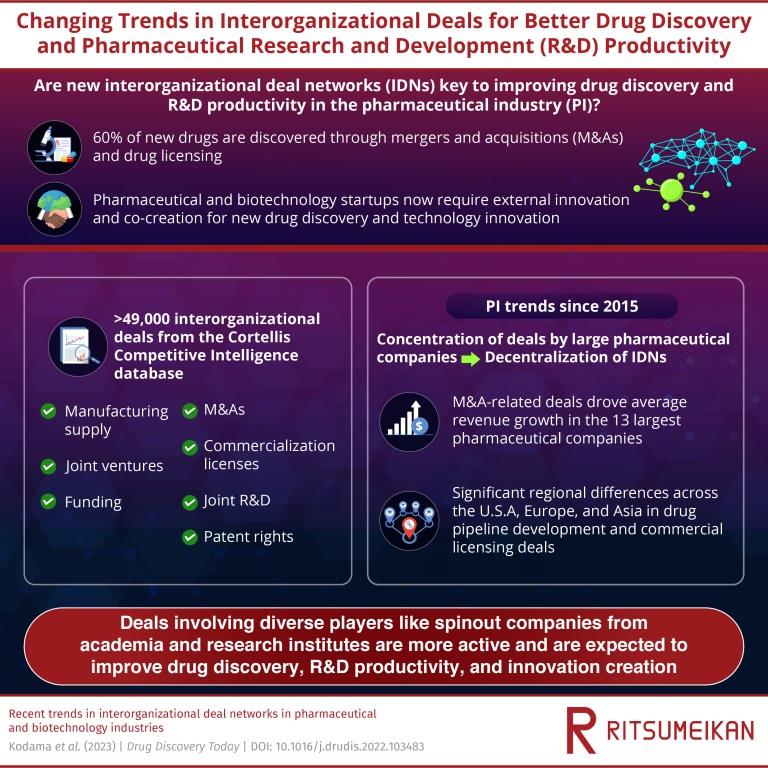Health
Research Shows Interorganisational Deals Boost Drug Discovery, Innovation

By Adedapo Adesanya
In a recent study published in the journal Drug Discovery Today, a team of scientists at Ritsumeikan University in Japan analysed the changing trends in pharmaceutical industries to spotlight the role of interorganisational collaborations in promoting drug discovery and innovation.
Discovering new drugs has become increasingly rare for independent large pharmaceutical companies in recent times. With numbers showing that almost 60 per cent of new drugs are discovered through mergers and acquisitions and drug licensing.
Now, the university researchers shed light on the recent trends of spinouts from academia and investments in the US and Europe, foreshadowing a promising shift in the industry’s interorganisational deal networks to improve research and development productivity in the future.
“It is a challenging feat to launch a new drug in the market, given the low probability of success during the research and development (R&D) phase and the high costs involved. In recent times, industry trends in external innovation for drug discovery are rapidly changing. With an improved understanding of disease biology, decision-making can be more streamlined through the effective use of scientific information,” a statement made available to Business Post said.
Led by Associate Professor Kota Kodama of Ritsumeikan University, the team is uncovering how the trends in interorganisational deals in the pharmaceutical industry are changing to improve R&D productivity and drug discovery.
“The network structure of innovation creation in the pharmaceutical industry has changed with the increasing emergence of start-up companies spinning out from academia and research institutions as players in the source of innovation,” explains Dr Kodama, while discussing their investigations into these changing trends and the results of which were made available online on December 27, 2022, and published in volume 28 issue 3 of the journal Drug Discovery Today on March 1, 2023.
Their research suggests that the knowledge necessary for breakthrough innovation in drug discovery is more often than not obtained through alliance networks.
Over the past decade, large research-based pharmaceutical companies have used research collaborations, innovation incubators, academic centres of excellence, public-private partnerships, mergers and acquisitions (M&As), drug licensing, and corporate venture capital funds as typical methods for external innovation.
The researchers now aim to define the changes in the network structure and nature of such alliances that have occurred over the past decade to provide future strategic insights for industry and academic players involved in drug discovery.
Using data from the Cortellis Competitive Intelligence database, the researchers identified nearly 50,000 deals of various kinds related to pharmaceutical R&D across pharmaceutical, digital health software, animal drug, and medical device companies to uncover trends in the creation of new drugs for human use.
They also studied the trends of 13 of the largest pharmaceutical companies with annual revenues of more than $10 billion, who saw an improvement in their CAGR (compound annual growth rate) since 2015.
The researchers noticed that the rising CAGR correlated to a significant change in M&A-related deals after 2015, indicating that M&A-related deals drive revenue growth for large pharmaceutical companies.
Furthermore, the number of organizations involved in interorganisational deals has been increasing yearly from 2012 to 2021. Although the number of organizations involved and the number of deals may be increasing, the density of the deal networks is decreasing annually, suggesting that networks are becoming more non-cohesive.
The concentration of business relationships between organizations of certain areas in the network changed to dispersion around 2015, and new networks connecting different groups started to form after 2017.
These trends are an important illustration of how the industry landscape is gradually evolving away from the traditional network in which large pharmaceutical companies drove drug discovery output. Now, interorganisational deals among more diverse players have become active and are driving R&D productivity for startups in biotechnology and pharmaceuticals.
A clear increase in the number of academia-owned spinouts of advanced technology and expansion of investment in start-ups is a positive sign. The emergence of new chemical modalities, such as biologics, oligonucleotides, and peptides that differ from traditional small molecule drug discovery, indicate remarkable changes that have taken place over the past two decades.
The trend of increased financing for start-up companies in personalized drug development is beneficial for patent creation and will positively impact innovation creation in the coming years.
“The presence of academia to support the technologies of these start-ups is becoming very important, and government and private support and investment in this area are boosting innovation. Our study shows that such medium- and long-term support may ultimately benefit the health and well-being of humankind,” Dr Kodama noted.

Health
Sault Tribe Enacts Smoking Ban in Kewaunee

Health and comfort have become increasingly essential issues lately, and this has not gone unnoticed in entertainment venues. The Sault Tribe, which operates the Kewadin Casino, has decided to ban smoking in five gambling establishments. This innovation is aimed at creating a healthier environment for all visitors and employees.
Health and comfort come first
Tribal representatives emphasized that people’s health is their top priority. The decision to ban smoking was a logical step toward positive change. “As a tribal government, we are focused on improving health, and the move to ban smoking in casinos is the right step forward,” notes one tribal speaker. This means caring about the health of visitors and the well-being of the employees who work in these facilities daily.
The Sault Tribe has been actively gathering opinions from its customers and employees, and the results have been unequivocal: many are in favor of banning smoking. “We have heard from many customers and employees that a smoking ban is the right step forward,” states a tribal spokesperson. Such feedback confirms that concern for health and well-being is becoming increasingly important to the gambling industry.
What will change at Kewadin casinos?
In the weeks following the passage of the amendments, Kewadin casinos located in Sault Ste. Marie, St. Ignace, Manistique, Christmas, and Hessel will begin implementing the new policy. The smoking ban will be in effect in all establishments, including gaming rooms, restaurants, and recreational facilities. This approach will not only make the casino experience more enjoyable for non-smoking visitors, but it will also create a safer environment for employees who spend much time in the gaming rooms.
Positive implications for business and society
The adopted initiative will not only bring health benefits but will also affect the success of businesses in the long run:
- The actions taken also emphasize the Sault Tribe’s social responsibility. They are not just in business but also show concern for the well-being of their customers and employees, making them an example for other gambling establishments.
- Banning smoking in Kewadin casinos will create a more pleasant environment for both non-smokers and those looking to quit smoking. Smoking in public places often makes other visitors uncomfortable, and this move will help eliminate the unpleasant odour and smoke, thus creating a more pleasant atmosphere throughout the gaming rooms, restaurants, and other recreational areas.
- The changes may attract a new audience interested in entertainment but previously avoided visiting casinos because of the smoking environment. This can lead not only to an increase in the number of guests but also, as a result, to increased profits for the establishment.
At the same time, avid smokers, which are still quite a lot, will be less likely to visit land-based casinos, where they are forbidden to relax in the usual way. Especially since today, they do not have to visit these establishments to satisfy their gambling needs.
Analyzing the search engine allows you to quickly find many popular operators, including 1win, with the largest number of gambling entertainment. And you can access these games without having to leave home. To register on 1win, it is enough to fill in a few fields in the appropriate window and develop a password. It takes less than a minute to do this and deposit money into your account. Moreover, most of the games can be played in a free demo.
Chippewa Tribe aims to create a “smoke-free” space that combines a healthy environment with the opportunity to relax and enjoy gambling. The new approach to business reflects and supports global trends aimed at caring for public health and reducing the negative impact of tobacco smoke on the health of others.
Recall that earlier, scientists told us about the new harm of smoking. According to new data, the negative impact of this bad habit on the immune system persists for several years after a person quits smoking.
Health
SpecSMART Eye Clinic Takes Affordable, Quality Care to Ikeja, Environs

By Modupe Gbadeyanka
The dream of residents of Ikeja and its environs enjoying affordable and quality care has now become a reality as a result of the opening of a new branch of SpecSMART Eye Clinic in the Opebi area of the capital of Lagos State.
SpecSMART Eye Clinic, a leading provider of optometry services in Lagos, commenced operations in Nigeria’s commercial capital in 2022.
Since then, it has been offering top-notch eye care to residents of the metropolis, especially those living on the Island. It has built a strong reputation for delivering high-quality primary eye care and optical products.
However, to extend its services to Lagosians living on the Mainland, it has now opened a new branch in Ikeja, reinforcing its commitment to providing accessible, affordable eye care to a wider community.
Business Post gathered that the clinic’s state-of-the-art services are supported by a team of skilled optometrists and opticians, utilizing cutting-edge digital equipment.
The new Ikeja location will offer a wide range of services, including Automated Eye Examinations using advanced digital equipment for precise diagnosis and personalized care.
In addition, clients will enjoy on-the-spot lens glazing for single vision, bifocals, and varifocals, with additional lens coatings, with services to be rendered seven days a week from 9 am to 9 pm on Mondays to Saturdays, and on Sundays and public holidays from 10 am 7 pm.
Also, the clinic has over 950 frames, ranging from affordable home brands to premium designer options, priced from N18,000, and has flexible appointment scheduling with 24-hour online booking via SpecSMART’s website.
The facility has partnerships with leading HMO providers in the country and offers glaucoma management and other essential eye health services.
According to the company, its introductory packages start from N30,000 and include consultation, frame, and single-vision lenses.
“With the opening of our Ikeja branch, we are ready to serve more individuals who need accessible, cost-effective, and reliable eye care.
“Our aim is to create a positive impact in Nigeria’s optometry sector by combining advanced technology with a patient-centred approach,” the Practice Head and Medical Director of SpecSMART, Dr Adaeze Nwoko, stated.

Health
FG Begins Vaccination Against Mpox in FCT, Six States

By Adedapo Adesanya
The Federal Ministry of Health and Social Welfare through the National Primary Health Care Development Agency (NPHCDA) has commenced the vaccination against Monkeypox, now known as Mpox.
Business Post reports that Bayelsa, Rivers, Cross River, Akwa Ibom, Enugu, Benue, and the Federal Capital Territory, were selected as pilot states for the vaccination.
An average of 631 persons are expected to be vaccinated across the seven states with two doses of the Mpox vaccine. A buffer for 50 persons will be kept at the national in case of an upsurge in other states.
NPHCDA in a statement posted on its verified X account confirmed the exercise, stressing that the vaccination will help to protect communities and safeguarding health of the people.
In a related development, according to the latest update by the Nigeria Centre for Disease Control (NCDC), there are 1,442 suspected cases of Mpox from 36 states and the Federal Capital Territory, while the number of confirmed cases of the infection was 118 from 28 states and the FCT.
“To prevent the spread of Mpox, we strongly advise the public to avoid contact with animals that may carry the virus, including sick or dead animals in affected areas, avoid handling materials that have been in contact with infected animals, limit unnecessary physical contact with individuals who are infected, practice frequent handwashing with soap and water, and ensure that animal food products are thoroughly cooked before eating.
“It’s also important to use protective clothing and gloves when handling sick animals or their tissues. Similarly, health workers are advised to follow standard safety protocols including droplet precautions when treating patients, use protective equipment including masks, gloves, and gowns, during patient care, and be vigilant for symptoms of Mpox, especially fever and rash, among other measures.”
-

 Feature/OPED5 years ago
Feature/OPED5 years agoDavos was Different this year
-
Travel/Tourism8 years ago
Lagos Seals Western Lodge Hotel In Ikorodu
-

 Showbiz2 years ago
Showbiz2 years agoEstranged Lover Releases Videos of Empress Njamah Bathing
-

 Banking6 years ago
Banking6 years agoSort Codes of GTBank Branches in Nigeria
-

 Economy2 years ago
Economy2 years agoSubsidy Removal: CNG at N130 Per Litre Cheaper Than Petrol—IPMAN
-

 Banking2 years ago
Banking2 years agoFirst Bank Announces Planned Downtime
-

 Sports2 years ago
Sports2 years agoHighest Paid Nigerian Footballer – How Much Do Nigerian Footballers Earn
-

 Technology4 years ago
Technology4 years agoHow To Link Your MTN, Airtel, Glo, 9mobile Lines to NIN












